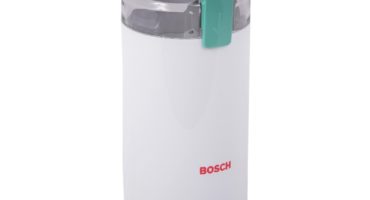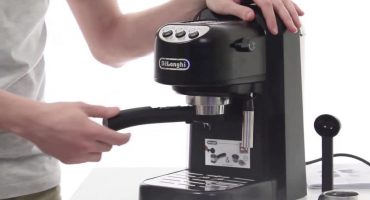The best assistant for coffee lovers is a coffee machine. In order for the device to serve for a long time, and the quality of the invigorating drink has always been at a high level, you need to systematically care for this device. Inattention to the coffee machine threatens the appearance of bitterness in the coffee and the occurrence of unwanted breakdowns in a fragile system. In addition, cleaning the coffee machine is a prerequisite for maintaining warranty service from the manufacturer.
When to clean
Any semi-automatic or automatic system for brewing coffee has its own way of warning about the need for decalcification. The coffee machine lets you know about the need for cleaning, based on the settings. Special sensors that determine the level of deposits have not yet been developed.

Coffee machine heating element before and after cleaning
The time when the machine needs to be decalcified is calculated based on the density and hardness of the water. The factory, as a rule, sets the values corresponding to the highest levels of stiffness. They are designed for the minimum number of cups that the device prepares (for example, 250 servings), after which you will need to clean the coffee machine.
In some devices, it is impossible to ignore the message about the need for maintenance: they can block themselves. Others will systematically issue a message about the necessary decalcification, allowing the machine to work.
The user himself can set the settings when the device requires regular cleaning, based on the hardness of the water. To do this, you need to conduct tests using strips to determine the quality of the liquid. They usually come with the device.
The test execution process is as follows:
- water used to make coffee is poured into a container;
- the test strip is lowered into the glass for a few seconds;
- spot one minute and wait;
- check the result: how many squares changed color.
1 square corresponds to the softest water, 2 - soft, 3 - hard, 4 - the hardest of the possible options.
In accordance with the result, you can set the appropriate settings for the coffee machine. For the mildest version, the service life before maintenance will be maximum, for the toughest quality it will be necessary to clean the instrument systems most quickly.
Coffee machines automatic and semi-automatic type: how to rinse
The basic procedure for removing plaque when cleaning the coffee maker has a professional name - decalcification. During this process, the device gets rid of the accumulated scale in the compartment where the water is poured. Each coffee machine has a set of instructions from the manufacturer. It describes in detail the process of decalcification of the device.
There is no single way to clean any coffee machine. Each manufacturer has its own characteristics and the number of steps that allow you to perform the procedure. Some devices require several steps, others force you to complete entire chains in which you can get confused. As a rule, premium brands seek to facilitate the task for their users and simplify the cleaning system to the necessary 2-3 actions on the part of the person.
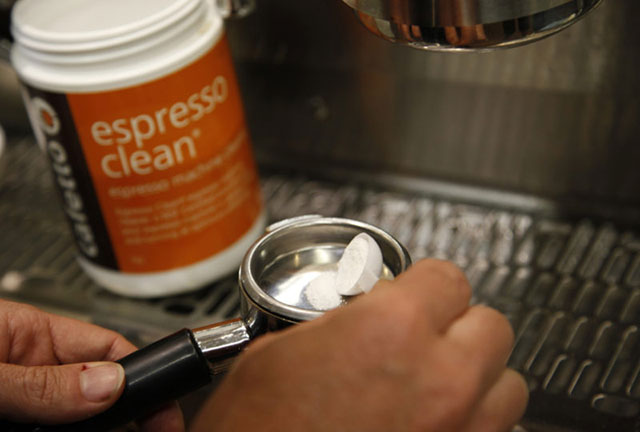
Dry Powder Cleaning
Example of how to clean the coffee machine:
- a chemical tank must be placed in the water tank for cleaning;
- the user just needs to press one button that indicates the beginning of the decalcification process (Calc, Decalc). Then the automatic cleaning system is switched on. It lasts at least 25 minutes. The procedure will be completed only after the signal of the machine to complete the work;
- After the procedure, it is necessary to thoroughly wash all moving tanks of the device.
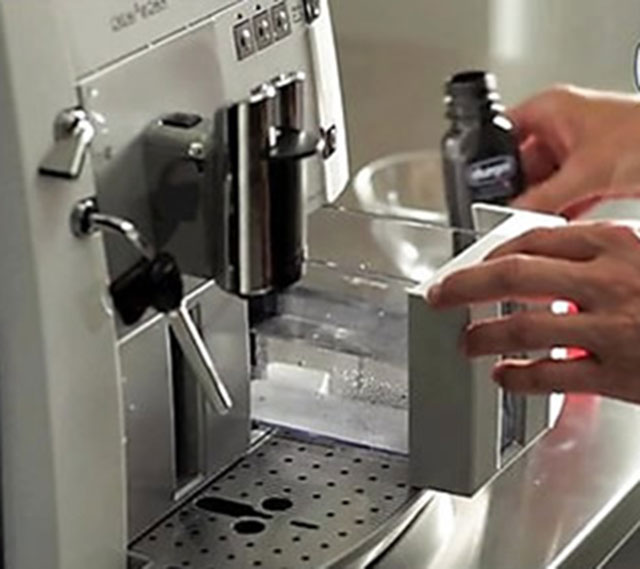
The process of introducing cleaning fluid
After thorough removal of traces of chemical components, the machine is loaded with plain water and several “single” brews are performed. Manufacturers advise sending the first couple of cups of coffee to the sink in order to surely get rid of chemistry that is unnecessary for the body.
Cleaning agents
To perform a successful cleaning procedure, you will need to not only carefully follow the instructions, but also use one of the products on the market. There are different types of tools for carrying out the procedure. These include:
- dry powders. Before getting into the tank of the coffee machine, the powder must be mixed with a liquid. The dissolved product is added to the device along with water, adding it to the maximum mark on the tank scale. Each brand has its own parameters of diluted powder, so you need to check the instructions before starting cleaning;

Powder for cleaning
- packing tablets. Type of dry powders pressed into a specific shape. The principle of operation is fully consistent with the first type of funds. The peculiarity is that the tablet must completely dissolve before starting its work in the tank of the coffee maker;

Cleaning tablets
- liquid products. Poured into a container of water immediately, without dilution;
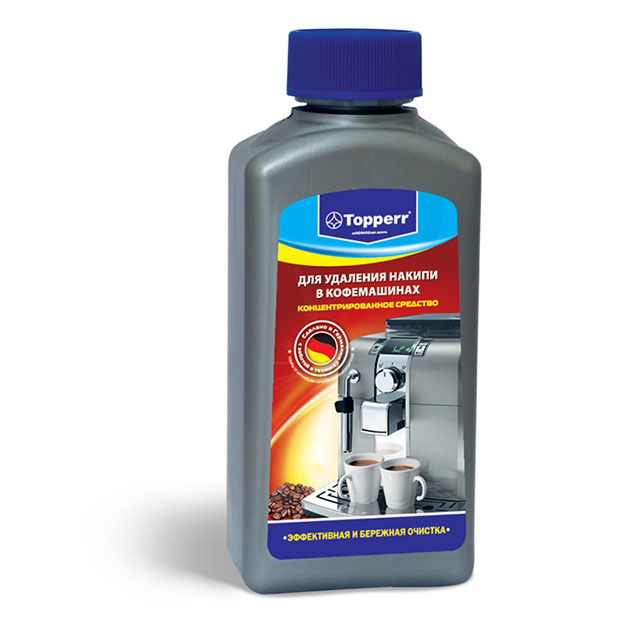
Liquid remedy
- sets of capsules. Used for capsule type machines.
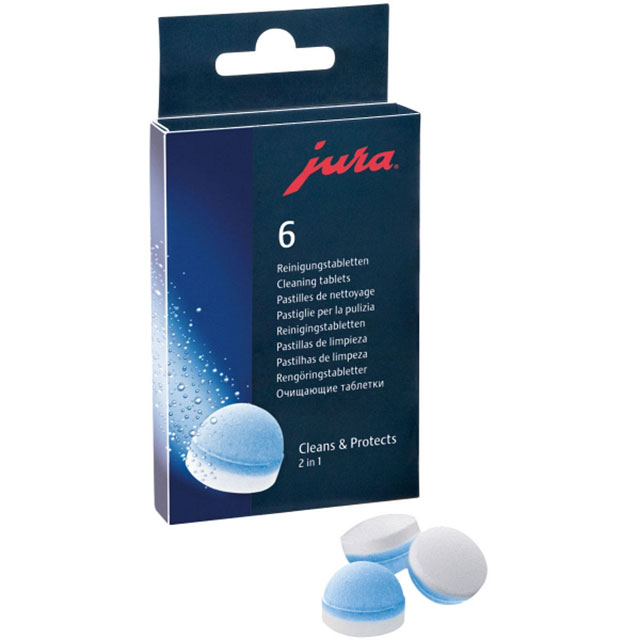
Soluble capsules for the decalcification process
Before cleaning, remove the filter from the coffee machine, otherwise it will be hopelessly damaged.
Manufacturers recommend using only their own funds, however, they themselves do not produce them. As a rule, brands turn to the same suppliers in order to obtain a product for cleaning and, packaging it in branded containers, make the price high. At the same time, cheap options of various cleansers are no different from eminent competitors. The main rule for preparing contaminant removal products is to observe the proportions declared by the manufacturer.
Among folk remedies, it is often recommended to use citric acid, vinegar essence or even Coca-Cola to get rid of scale. If you decide how to use folk remedies, you should know that non-professional components can not only not fulfill the function assigned to them, but also harm the device.
Vinegar will break immediately, and citric acid, when used systematically, will corrode the rubber and aluminum parts of coffee machines. Coca-Cola may not show any positive effect.
If professional cleaning products are not possible, you can resort to the use of citric acid as a last resort. To do this, you need to dilute 10 grams of powder in one liter of liquid and fill the reservoir of the coffee machine with water with the resulting mixture. After that, the usual actions that comply with the instructions are performed.
Carob type coffee maker: how to clean
In coffee machines that use the grain version of coffee, there is always a brewing unit. In the process of using the device, the part begins to contain excess coffee oils on its walls. According to the location of the brewing unit, a removable and a built-in option are distinguished. Cleaning the system of coffee oils varies depending on the location of the nodes.
For carob type coffee makers the function of the warovik is the horn.

The process of removing fat from the removable part
Removable unit. Its cleaning is carried out by removing from place and washing under running water.After complete drying, the system will be placed in its original place. The procedure is performed every few weeks, depending on the frequency of operation of the coffee machine. Additional cleaning must be done every 300-400 cups. Varovik, aka a removable unit, is cleaned along with the supply of water using chemical agents.
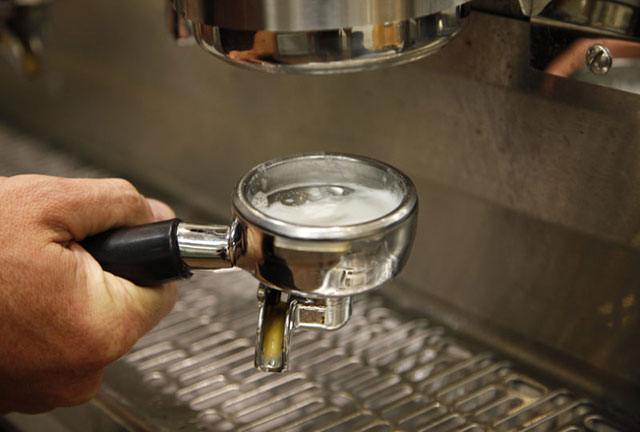
Flushing the removable unit
Built-in warovik. In coffee makers with a built-in brewing system, cleaning occurs automatically using special tablets. Keeping these coffee machines clean is even more important than with a removable unit. If neglected, the device will quickly fail.
The process of purification in pouring coffee machines is carried out in 8 steps:
- coffee is removed from the warovik;
- the cleaning agent is placed in the compartment for ground grains (1 tablet or 3 grams of powder). Pour 2 liters of water into the car;
- turn on the preparation of ground grains;
- put the container under the nose of the distribution;
- set the maximum size of espresso in the settings;
- pour liquid into the cup into the sewer;
- half an hour after the completion of the process, let the car stand;
- thoroughly rinsing the apparatus with fresh water.
In cases where the manufacturer has equipped the machine with sensors that impede the operation of the device in the absence of grains in any form, you will have to place the cleaning agent in the brewing unit. After performing the cleaning, it is necessary to flush the waterway using the additional button in the menu.
How to clean capsule, geyser and other types of coffee maker
Any coffee maker requires careful care and cleaning. The easiest way to clean geyser and drip devices. They are completely disassembled and easily washed under running water. In the geyser system, it is necessary to pull out and thoroughly rinse the sieve, and in the capsular system, if there is a metal filter, you need to pay attention to it.
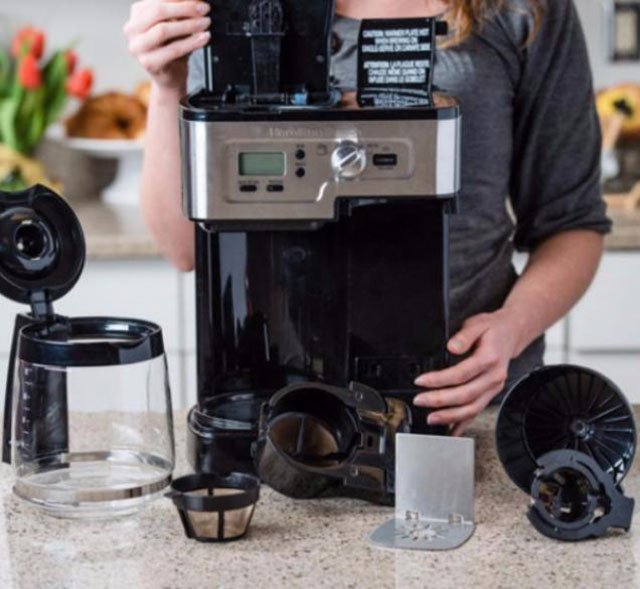
Disassembled general-purpose coffee maker
In case of capsule-type coffee maker you don’t have to put a lot of effort either. The brewing unit in such a machine is presented in the form of a loading capsule. Due to this, care for the place of its introduction is not required. To clean the internal tracts, it is enough to use special tablets for capsule coffee machines and carry out cleaning using the built-in program by pressing a single button. Cappuccinators in such devices are most often absent, but if it is available, daily cleaning under running water is necessary.
Milk circuit cleaning at milk machines
The issue of cleaning the milk tract is especially popular with machine owners who have an automatic cappuccino machine. However, it is necessary to clean any kind of devices that have means for whipping milk foam.
For panarello, it is enough to unscrew the tube and rinse it under running water. For various types of milkman, it is necessary to rinse under running water after each use. The automatic device must be cleaned by changing the milk to water and starting the fluid supply. If the contamination is not strong, 50 ml of water will be sufficient for complete purification.
If the ducts dry after a forgotten cleaning, you will have to use special cleaning products. Manufacturers offer a wide range of different cleaning products with different price categories. In fact, absolutely everything will cope with pollution, even the cheapest means.
Experts recommend washing milk jugs twice a week in dishwashers or under strong pressure of running water. Such a systematic method of cleaning will relieve the use of chemistry for many years.
Means for cleaning the dairy site:
- liquids for dairy systems. Eliminate dried milk particles. It should be used systematically every day, adding about 20 ml to the node;
- liquids used to clean cappuccinators;
- pressed tablets for dairy nodes.
For coffee makers of any type, constant systematic monitoring of cleanliness is required. Delay if necessary, cleaning can lead not only to a poor-quality finished drink, but also to a significant breakdown inside the machine. Attention must be paid to all parts of the apparatus, starting with the most important brewing parts, ending with grinding systems. Manufacturers offer a wide selection of special tools for professional cleaning, just find your own and choose a convenient dosage for high-quality cleaning of the coffee machine. Constant care and respect will help the device last a long time and prepare only a delicious coffee drink.

